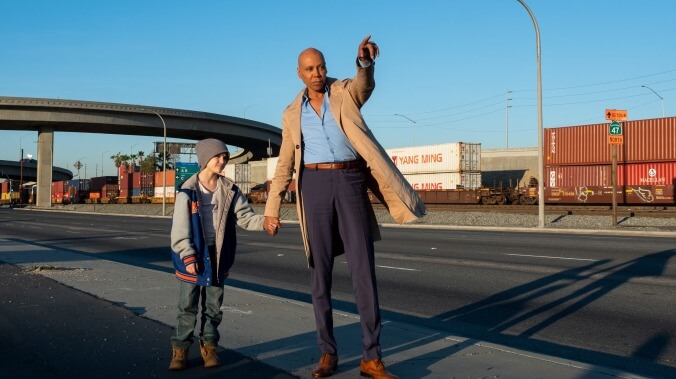RuPaul’s AJ And The Queen is a charming sitcom showcase for the man beneath the wigs


RuPaul Charles, the man who helped transform drag from an underground movement into a pop culture phenomenon, is fond of emphasizing the power each of us has to not just invent but reinvent ourselves as the person we want to be—something that is fascinating to consider in the light of Charles’ new persona as, potentially, a true actor. Charles teamed up with Sex And The City executive producer Michael Patrick King to co-create the Netflix comedy AJ And The Queen, and the pair keeps the narrative simple, invoking tales of intergenerational friendship like Paper Moon, About A Boy, The Professional, and more—but with 100 percent more wigs.
In the series, Robert (Charles) is an aging drag performer, with the stage name of Ruby Red, who has spent years working to save enough money to open his own club (proposed name: Queens In Queens). But after his bank account and his heart both get trampled by con artist Hector (Josh Segarra), he’s desperate for money and still in possession of his vintage RV, so he sets out on a cross-country tour from New York City to Dallas to try to recoup a fraction of his losses. The complication is that AJ (Izzy G.), the 10-year-old daughter of his drug-addicted neighbor, decides to stow away on the trip. With her mother proving unreliable, AJ wants to move in with her grandfather in Texas, and Robert reluctantly lets her join him, even while Hector and his accomplice Lady Danger (Tia Carrere) are trying to chase him down.
Pairing an older actor with a precocious kid is hardly a new formula for a film or TV show—less than a year ago, there was the Idris Elba Netflix comedy Turn Up Charlie, and shows of this ilk tend to have two things in common: Their watchability is extremely dependent on your tolerance for precocious kids (especially if “precocious” gets mistranslated as “obnoxious”), and they offer up an opportunity to better understand the adult by the way in which they interact with said younglings. In this case, that leads to the growing affection between Robert, who has a big heart that’s used to getting hurt, and the equally vulnerable AJ, who presents a tough front despite yearning for familial love.
As the show’s second lead (and narrator, in voice-over moments at the beginning and end of each episode), Izzy Gaspersz proves more than capable of standing her ground opposite Charles, and handles AJ’s deeply internalized anger with an appropriate level of rawness. She also has a killer deadpan delivery on some of her sharper lines (says Robert at one point, “I’ve never seen you read. I’ve been read by you before, though”). Meanwhile, the show’s guest stars include a legion of well-known drag queens who owe a lot of their fame to appearing on Drag Race, including Ginger Minj, Latrice Royale, Trinity The Tuck, Pandora Boxx, and more. Like Charles, they’re not playing their established drag personas, preserving the show’s veneer of fiction. But said fiction does lead to something that’s hard not to think about while watching: Whether or not, in the world of the show, a drag performer named RuPaul ever became a game-changing superstar who, over the course of decades, completely changed the public awareness of this subculture.
This matters a great deal when you consider just how iconic RuPaul is to the world of drag. In fact, in some ways, it’s simplest to explain this aspect of AJ And The Queen by imagining Lorne Michaels making a heartfelt comedy about a struggling late-night sketch show in the 1990s, in an alternate universe where Saturday Night Live doesn’t exist. That choice brings with it a certain level of humility—as if Charles is actively trying to dodge acknowledging the depth of his cultural impact. And also, by choosing to play a character separate from his RuPaul persona (admittedly with some familiar crutches), he has somehow found a way to be more vulnerable and open than ever before.
When RuPaul first broke out, it was in some ways as a constructed persona, fabulous and fierce and unafraid to read those in the immediate vicinity. Charles has plenty of acting experience, going back to the early 1990s with appearances in Crooklyn, The Brady Bunch Movie, and of course the iconic To Wong Foo, Thanks For Everything! Julie Newmar. But so many of those roles don’t differ all that dramatically from the persona Charles has carefully cultivated over the years. Meanwhile, on AJ And The Queen, he might, on the surface, be playing a character not very far removed from what we’ve seen him do in the past. However, the truth is that it is something very, very different. Here, we actually see the man in question, stripped down, makeup-free—and thus perhaps the rawest and most vulnerable he’s ever been on screen.
There are moments that feel a little jarring, such as the semi-regular mention of Ruby’s food issues, echoing regular jokes made on Drag Race about how two Tic Tacs are more than enough for a meal. In the pageantry of that show, it’s not off-putting, but because AJ And The Queen actively courts a more grounded feel, there are points when you want to take Ruby aside and talk to him about his problems. Also, each of the 10 episodes is in the hour-long range, and frankly, the half-hour-per-episode version of this show might have ultimately been stronger, even though many episodes don’t feel overlong.
Beyond those moments, there are so many freewheeling touches over the course of the season that keep the fun alive, from an extended tribute to the brilliance of costume designer Bob Mackie to a dependable recurrence of expertly staged drag numbers. Why does Tia Carrere wear an eyepatch, you might ask—but really the question is, why the hell not have her wear an eyepatch? (For the record, the True Lies star is having a ton of fun here.)
On balance, AJ And The Queen doesn’t avoid moments of camp, and that’s not a bad thing—no one needs this show to be The Wire. But it does strike the necessary balance between grounded reality and lighter fare, given the subject matter (the federal government has a few things to say about transporting a minor across state lines without parental consent, after all). And while his long and groundbreaking career has been defined since 1993 by the “Supermodel” lyric “You better work,” this show might be the bravest thing RuPaul has ever done.